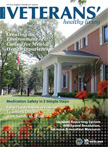Veterans' Healthy Living, Spring 2014
Incident Reporting System Will Speed Resolution,
Increase Prevention Measures
Incidents that are dangerous for patients or staff at a VA facility—or have the potential to be dangerous—must be managed quickly. But incidents must first be reported, and any tool that can speed up the reporting process is a benefit to all. The VA Medical Center in White River Junction is currently testing a new tool to do just that.
An electronic system, now in testing, allows patient safety professionals to track such events much faster than before. It will also help staff provide quick solutions and develop prevention strategies that will head off future incidents.
An incident is any item or event that has harmed or might harm patients or staff. It can be anything from an incorrect dosage of medication, to a broken chair leg, to a cracked sidewalk.
“Incidents are usually submitted via paper reports, but paper submission can be onerous,” said Debra Scott, Patient Safety Manager. “This electronic system is a much more effective way to gather information.” Incident reports are protected by law, however, and must be kept for reference. “Paper is not going away,” explained Deborah Cutts, Chief Quality Officer. “It’s still a useful mode of reporting.”
 Once officially launched, staff at the facility can use the online method to provide a synopsis of a situation. The point-and-click system will guide submitters through the process, allowing them to provide as much information as necessary. If the reported situation affects a patient, the system also verifies the patient’s identification number. Submissions can be anonymous if the submitter is uncomfortable disclosing his or her identity, although users are invited to provide contact information for follow-up so the incident team can gather more information if needed.
Once officially launched, staff at the facility can use the online method to provide a synopsis of a situation. The point-and-click system will guide submitters through the process, allowing them to provide as much information as necessary. If the reported situation affects a patient, the system also verifies the patient’s identification number. Submissions can be anonymous if the submitter is uncomfortable disclosing his or her identity, although users are invited to provide contact information for follow-up so the incident team can gather more information if needed.
Reports go directly to a risk manager and to Scott; they determine who can best handle the situation and contact that person or group, usually within two business hours.
Situations may be resolved, but they are not forgotten. Treating each incident as a learning opportunity, incident teams may develop and initiate preventative steps to keep the situation from recurring. For instance, a leaky pipe that created a potential slip and fall situation may not be the only weak pipe in the area, so preventative steps may include checking other pipes to locate and repair other leaks.
While it might seem contrary to logic, the goal of using the electronic system is to increase the number of reports submitted, particularly those caught and resolved before they cause harm. The monitoring group expects to receive 125-200 reports per year through the system. “We are encouraging all patients and staff to speak up about matters that could affect patient safety,” added Scott. “It’s one more way to create a culture of safety.”
Mental Health Unit | Medication | Patient Safety Residency | Preventing Falls | Incident Reporting

















